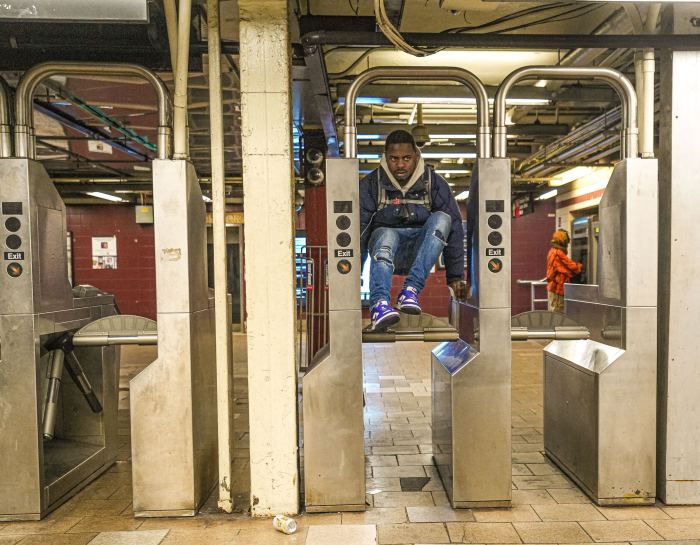
Local environmental groups are intensifying their two-year-long fight to stop a controversial pipeline carrying fracked gas that they say will threaten marine life in New York Harbor.
As the April 25 deadline for federal approval of the Northeast Enhancement Pipeline approaches, pipeline opponents are bracing for the Federal Energy Regulatory Commission to approve the project. If it is approved, Oklahoma-based Williams Energy could build a 23-mile offshore pipeline connecting an existing pipeline underneath Queens’ Jacob Riis Park to New Jersey’s Raritan Bay. The commission found the project’s environmental impact to be minimal and temporary in its environmental impact statement filed Jan. 25.
Stop the Williams Pipeline, a coalition of over 200 groups opposing the pipeline, says the project will set back the recent revitalization of marine life in New York Harbor.
“There has been such a rebirth of life in these waters,” said Paul Sieswerda, founder of Gotham Whale, a citizen scientist group that tracks whales. “We would like to keep it that way, but this pipeline is a problem.”
These grassroots organizations have mobilized with the support of New York City Comptroller Scott Stringer, City Council Speaker Corey Johnson and over 60 other elected officials who pressed the issue at the Green New Deal Forum on March 20.
The coalition has been generating local momentum with additional public hearings with the New York State Department of Environmental Conservation. Through these hearings and public outreach, they collected and delivered 10,000 comments, all opposing the pipeline, to the DEC.
This grassroots campaign will put pressure on Gov. Andrew M. Cuomo, who has not responded to the petitions, says Lindsay Meiman, spokeswoman for climate change advocacy group 350.org.
“This is a chance for Cuomo to show he’s a real climate leader,” said Meiman
New York State will have to make a decision on state permits by May 16. Without state approval, the pipeline cannot be built, says Peter Blair, environmental lawyer for Clean Ocean Action, a water quality advocacy group.
The nine months of construction will involve dredging and digging as deep as eight feet into the ocean floor. Arsenic, lead, zinc, and mercury have solidified on the ocean floor from past industrial dumping. Digging would resuspend these toxic chemicals in the water. That disruption, says Sieswerda, could harm menhaden, a fish in the herring family.
“Menhaden is the basis for why all the life has been returning to New York waters,” said Sieswerda. “They have been enticing the whales to come to New York City.”
Whales, once native to New York City waters, were a rare sight 10 years ago. Sieswerda’s group reported 200 whale sightings last year. The survival of these whales is dependent on menhaden who are filter feeders. During the construction, there will be a lot of debris in the water from the displaced sediment. The menhaden will not be able to filter the plankton they feed on because it will be covered in sediment, says Sieswerda.
Oysters, another filter feeder of plankton, will also be affected. The Billion Oyster Project have reinstituted oysters and reefs along the waters of Staten Island in the area of the proposed pipeline. The debris from digging will smother oysters, says Sieswerda.
New York City waters are also home to endangered Atlantic sturgeon and North Atlantic right whales, and the critically endangered Kemp’s ridley sea turtle. These species live in the area of the proposed pipeline, according to Kim Fraczek, director of Sane Energy Project, a sustainable energy advocacy group.
“I’m a realist. People want to be warm in the winter and cool in the summer,” said Sieswerda who acknowledged the difficulty of supplying enough energy to the city. “I just don’t want them to harm the marine life.”
There is an existing pipeline in New York lower bay, but the area needs a second pipeline to meet rising demand, says Chris Stockton, spokesman for Williams Energy. New York State is the fourth-largest consumer of natural gas in the country, most of which is fracked, says Stockton.
“Renewables are important,” said Stockton. “But New York uses a lot of natural gas and having an affordable reliable fuel like natural gas will be important for the city’s energy future.”
The coalition released their own independent report authored by Suzanne Mattei, former director of the DEC, who found the pipeline to be “completely unnecessary and dangerous.”
The project will come at a cost of almost $1 billion, and under federal regulations, energy companies are entitled to a guaranteed 14 percent return on equity for projects like pipelines. Even if the pipeline is not profitable, consumers will be paying out that 14 percent.
New York State Deputy Secretary of Energy and Environment Dale Bryk represented Cuomo at the Green New Deal Forum. Over interruptions and loud chants of “the Williams Pipeline-Cuomo stop,” Bryk would not reveal the governor’s stand on the pipeline.
Noelle Piconne, a representative for environmental citizen activist group Surfrider, is confident that the governor won’t allow the pipeline to be built.
“Cuomo has no choice if he wants to be part of the Green New Deal, if he wants to be a climate leader,” said Piccone





































